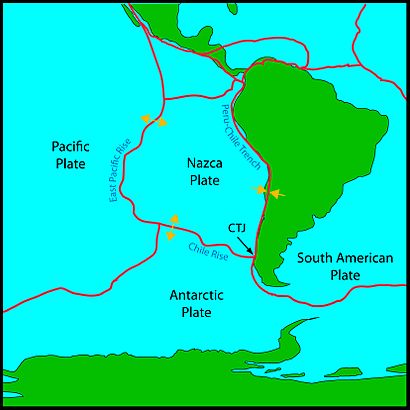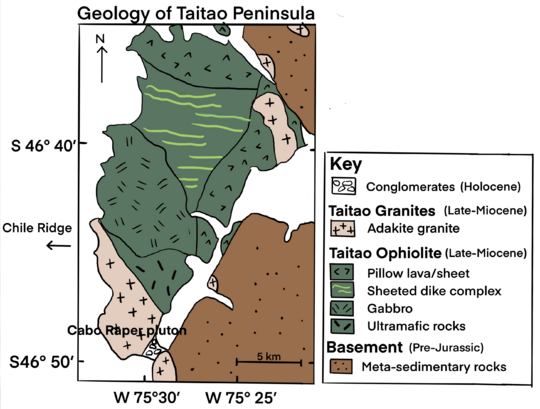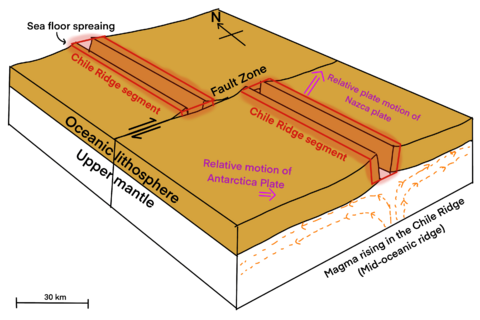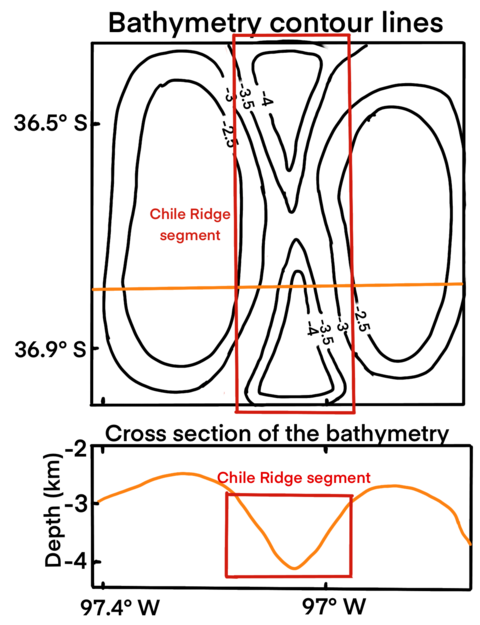Chile Ridge facts for kids
The Chile Ridge, also called the Chile Rise, is a long underwater mountain range. It forms where two huge tectonic plates, the Nazca Plate and the Antarctic Plate, are slowly pulling apart. This pulling apart is called a divergent plate boundary. The ridge stretches from a special meeting point of three plates (Nazca, Pacific, and Antarctic) all the way to the southern coast of Chile. You can spot the Chile Ridge on a map because it's broken into many parts by lines called fracture zones. These lines cross the ridge segments at right angles, making it look like a ladder. The entire ridge system is about 550 to 600 kilometers long.
The Chile Ridge is always spreading. It crashes into the southern South America Plate to its east. Since about 14 million years ago, parts of the ridge have been sliding underneath the Taitao Peninsula. This process is called subduction.
When the ridge subducts, it creates a special "slab window" under the South America Plate. This window is a gap where hot upper mantle material can rise. This process also forms unique rocks like the Taitao ophiolites. These are ultramafic rocks, often found in oceanic plates. The subduction also creates granite rocks in the Taitao Peninsula.
Studying the Chile Ridge is important. It helps us understand how the Earth's continental crust might have first formed from deep ocean crust.
Contents
History of the Chile Ridge
Around 14 to 3 million years ago, several trenches collided with the Chile Trench. This helped form what we now know as the Chile Ridge.
In 2010, a very strong earthquake (magnitude 8.8) struck near the ridge.
What is the Chile Ridge Made Of?
The rocks and features of the Chile Ridge are closely linked to the Taitao Peninsula. This is because the ridge slides under the peninsula, creating special types of rocks there. We will look at the main rock types, starting with the newest ones.
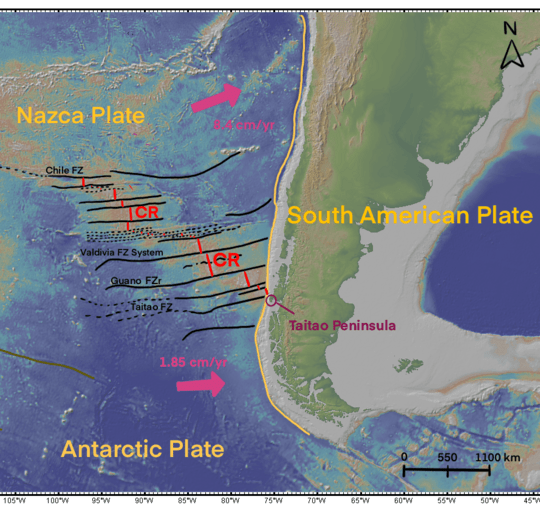
Taitao Granites
These rocks are a type of granite called Adakite. They formed when the edge of the Nazca Plate melted. This melting happened because the Chile Ridge was subducting under the South American Plate. The Nazca crust was young and warm, which allowed the rocks to melt.
What are Taitao Granites like?
Adakite rocks are usually light-colored and rich in silica. When the rocks melt, they change into other minerals like garnet.
Taitao Ophiolite
Taitao ophiolite Along the Chile Ridge, we find mafic and ultramafic rocks. The Taitao ophiolite complex is found in the western part of the Taitao Peninsula. It formed when the Nazca Plate pushed up and over the South America Plate. This process created the ophiolite rocks. It also shows that hot water changed the rocks in this spreading ridge area.
What are Taitao Ophiolites like?
Taitao ophiolite rocks are found in a special order from top to bottom. They include pillow lavas, sheeted dikes, gabbros, and ultramafic rocks. The ultramafic rocks show that melting happened at least twice in the past.
The way the subduction zone is set up affects the rocks and magma. When the Chile Ridge subducts, it changes how magma forms. By studying the magma's makeup, scientists can learn about the subduction system. For example, the "slab window" created by the subduction forms a type of magma called alkali basalt.
Underwater Landscape of the Chile Ridge
Scientists study the bathymetry of the Chile Ridge. This means they map the depths and shapes of the seafloor. They found large underwater hills called abyssal hills on both sides of the ridge.
These hills grow in cycles. As the Chile Ridge pulls apart, tiny cracks form. These cracks link up to create larger faults. These big faults push older, inactive faults away from the ridge. This process repeats, so the farther an abyssal hill is from the ridge, the older it is.
How the Chile Ridge Moves
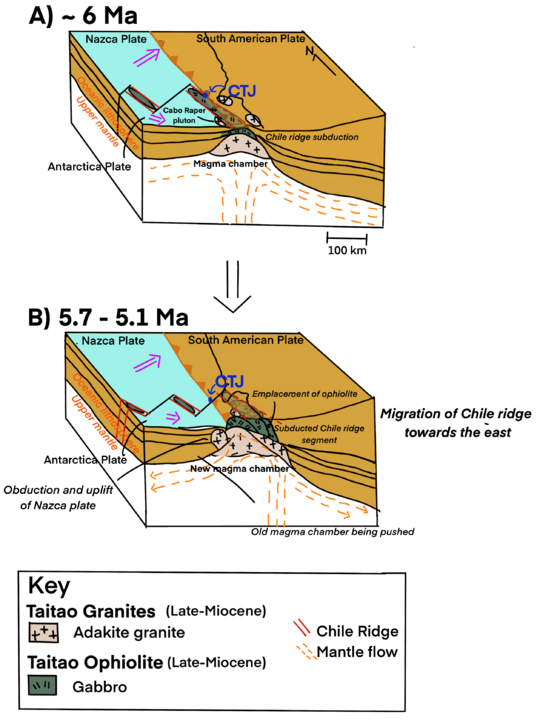
Spreading of the Chile Ridge
The Chile Ridge forms because the Nazca and Antarctica plates are moving apart. It has been actively spreading at about 6.4 to 7.0 centimeters per year since 5 million years ago. The difference in how fast the Nazca and Antarctica plates move creates this 550-km-long ridge. The Nazca Plate moves about four times faster than the Antarctica Plate.
Also, the Nazca Plate moves east-northeast, while the Antarctic Plate moves east-southeast. This difference in direction helps the Chile Ridge spread.
| Name of the Plate | Direction of movement | Rate of movement |
|---|---|---|
| Nazca plate | N77°E (ENE) | 6.6–8.5 cm/year |
| Antarctica plate | N100°E (ESE) | 1.85 cm/year |
Ridge Migration and Subduction
The subduction of the ridge started about 14 million years ago. It slides under the southern Patagonia region at an angle. This means that parts of the Chile Ridge are subducting under the South American Plate while the ridge is still spreading.
Because the plates move at different speeds, a "slab window" forms. This is a gap under the South America Plate. Here, the plate has little support and is directly exposed to hot material from deep inside the Earth.
Studies of magnetic anomalies in the ocean crust show that parts of the Chile Ridge subducted under southern Patagonia between 14 and 10 million years ago. From 10 million years ago until now, the ridge has been broken into shorter pieces by fracture zones. These pieces are subducting further north. This shows that the Chile Ridge has been moving northward over time.
Earthquakes Near the Ridge
Scientists use seismic stations to study earthquakes near the Chile Triple Junction. Earthquakes in this area are mainly caused by the subduction of the Chile Ridge. As the Nazca and Antarctica plates pull apart and collide with the Chile Trench, a gap forms. This gap is where new crust forms very slowly.
Moderate to strong earthquakes (magnitude higher than 4) happen along the segmented Chile Ridge. They also occur along the transform faults. It is believed that the subduction of the spreading Chile Ridge causes these earthquakes.
Chiloe Microplate
This is a small plate located east of the Chile Ridge, between the Nazca and South American plates. The Chiloe Microplate is moving northward compared to the South American Plate, which stays mostly still. This movement has created the Golfo de Penas basin.
Liquiñe-Ofqui Fault System
The Liquiñe-Ofqui fault system is a major fault that separates the Chiloe Microplate from the South America Plate. The northward movement of the Chiloe Microplate along this fault created the Golfo de Penas basin.
This fault is very active. Many earthquakes happen along it. In 2007, a large earthquake (magnitude 7) occurred here. This earthquake released stress from the Nazca Plate subducting under the South America Plate.
Patagonian Slab Window and Earthquakes
There is a gap in earthquake activity between 47° and 50°S. This area has unusually high heat flow. This gap matches the location of the Patagonian slab window. Only small earthquakes (magnitude less than 3.4) are found here. This is because the Antarctica Plate subducts at a shallow angle, causing very little earthquake activity.
Geological Features from Ridge Movement
Patagonia Slab Window
The most important result of the Chile Ridge subduction is the "slab window." This window forms when parts of the spreading Chile Ridge slide under the southern South America Plate. The Nazca Plate melts completely, and the Antarctic Plate pulls away. This creates a widening gap between the two plates.
Very little magma is produced under this slab window. The mantle here is hotter than the mantle that melts from the crust. Magma forms slowly because there is not much water in the subduction zone. This slow magma movement also creates a gap in volcanic activity above the slab window.
Scientists have proven the slab window exists under southern South America. They found a gap in earthquake activity that matches the slab window location. Studies also show a low-velocity zone in this area, meaning seismic waves travel slower there.
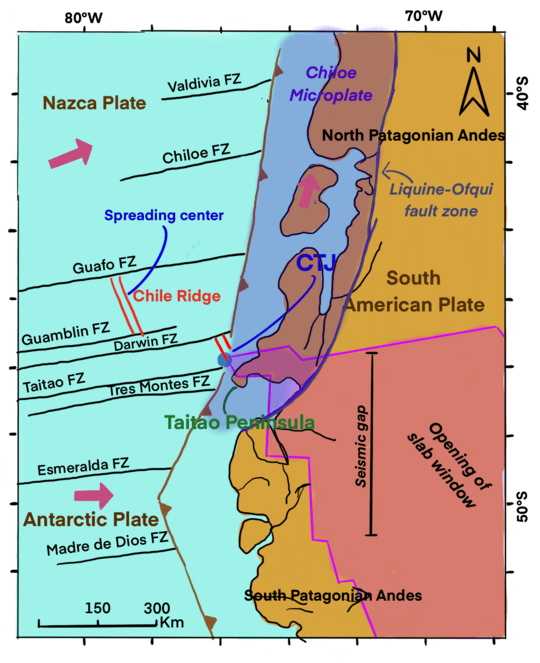
Tectonic Erosion and Ophiolite Formation
Besides the slab window, the Chile Ridge subduction also affects the Taitao Peninsula. This includes tectonic erosion (where the overriding plate gets worn away) and tectonic uplift (where land rises). The pushing up of the Nazca plate also helped form the ophiolite complex.
Chile Triple Junction
The Chile Triple Junction is where the Nazca, Antarctica, and South American plates meet. Its position changes over time. If the spreading ridge subducts, the junction moves north. If a fracture zone subducts, it moves south.
The junction has been moving north since the Chile Ridge started subducting about 17 million years ago. It is now located near the western Taitao Peninsula. The temperature at the junction, deep underground, is estimated to be very hot, around 800-900°C.
Ridge Axes
The ridge axes are the central parts of the ridge where new crust is constantly forming. The main axis of the Chile Ridge runs north-northwest. These axes are also known as rift valleys. Satellite data shows that there are areas of lower gravity near the ridge axes.
Fracture Zones
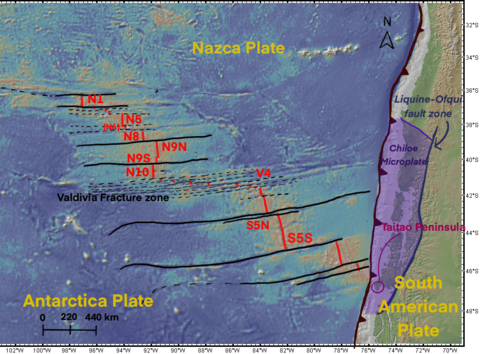
These are also called fault zones. They are transform faults that divide the Chile Ridge into many segments. This makes the entire ridge axis trend southeast. The fracture zones themselves trend east-northeast.
There are 18 fault zones that offset the Chile Ridge axis by a total of 1380 km. The longest is the Chiloe fault (234 km), and the shortest is the Guafo fault (39 km). Scientists use magnetic and bathymetric data to find these fracture zones.
Segmentation of Chile Ridge
The Chile Ridge is made of many short spreading segments. These segments have different lengths and offsets. For example, segments range from about 20 to 200 km long.
Hourglass Shape
The ends of the ridge segments are deeper, while the center is shallower and narrower. This creates an "hourglass" shape.
Valdivia Fault Zone
Valdivia Fracture Zone This fault zone is in the middle of the Chile Ridge. It divides the ridge into northern and southern sections. The Valdivia Fault Zone offsets the ridge by more than 600 km.
Chile Ridge and Chile Trench Interaction
Scientists have studied the heat and geology where the Chile Ridge meets the Chile Trench. They found that the spreading ridge changes slightly when it collides with the trench.
The South America Plate is greatly affected by this collision. The Chile-Peru Trench becomes steeper and narrower as the Chile Ridge subducts. The collision can also cause parts of the ridge to push up onto the land.
Measurements show high heat flow in the collision zone of the trench. This high heat is linked to the Chile Ridge subduction.
Why is Spreading Ridge Subduction Important?
Understanding how spreading ridges subduct is very important. It helps us learn how continental crust evolves. The Chile Ridge subduction is a great example because it's the only place in the world where a spreading ridge subducts under a continent. This allows scientists to compare ancient rocks with current processes.
Also, because of the Patagonian slab window and the pushing up of the Nazca plate, geological processes here have changed over time. This means the Chile Ridge subduction does not follow the "uniformitarian principle" (the idea that past geological processes are the same as today's).
See also
 In Spanish: Dorsal de Chile para niños
In Spanish: Dorsal de Chile para niños
- Fault zones
- Liquiñe-Ofqui fault
- Peru-Chile Trench
- Subduction
- Taitao Peninsula
- Valdivia Fault Zone


